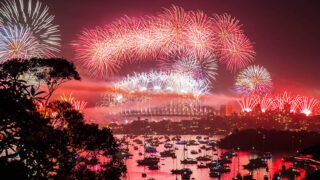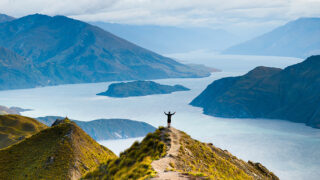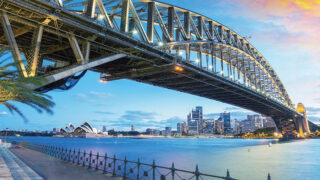There are so many things to do in Japan – it’s an epic travel destination, whether it includes admiring the sakura (cherry blossom), riding a high-speed train, trying to spot geisha in Kyoto’s old streets, sampling Tokyo’s street food, or relaxing in a hot-spring onsen. Before you go, read our travel planner below, with tips on where to ski, info on the weather, culture, language, money and more to help you build your Japan Itinerary!
#1 Fact File
Japan’s population is currently declining slightly each year. In 2024, it is around 122 million, down from 123 million in 2023. The Japanese capital Tokyo is considered the world’s largest city, with 37 million people in the greater metropolitan area.
The size of Japan’s population is quite remarkable when you consider the fact that 80 percent of the country is mountainous, with the Japanese Alps running down the centre of Honshu. Mount Fuji is the highest mountain, at 3,776 metres. It’s famous for its perfect conical shape.
Two main religious faiths are followed in Japan – Shinto and Buddhism. Over 40 percent of the population practices each one.
#2 Trivia
- From coffee to ramen, and umbrellas to flowers, Japan’s ubiquitous vending machines dispense just about everything you need to get through the day. There is apparently one vending machine for every 24 people in Japan.
- Japan is located on the Pacific Ring of Fire, and sits on the junction of three tectonic plates. As a result, something like 1,500 earthquakes strike the island nation every year on average.
- A Japanese construction business named Kongō Gumi was in operation for a world-record 1,400 years, until it became a subsidiary of another company in 2006.
- In 1978, graphic designer Tomoyuki Ono invented watermelons shaped like a cube. The fruit is placed in boxes and fills the shape of the box as it grows. These mostly ornamental melons are often many times the price of the normal spherical variety.
#3 Key Dates
The most important public holiday in Japan is shogatsu – New Year – on 1 January. Families hold “year forgetting” parties where they clean houses, visit relatives and leave the previous year’s troubles behind.
11 February is National Foundation Day, marking the inauguration of Emperor Jimmu, the first Japanese emperor, in the seventh century BC.
#4 Your Japan Itinerary

For experiencing the best of Japan, the easiest itinerary plan is to determine how many of the four main islands you’ll have time to visit.
- On Honshu, you can explore Tokyo, Osaka and Kyoto.
- Kyushu, in the south, is home to Fukuoka, Nagasaki, Beppu and Yufuin.
- Hokkaido – Japan’s skiing capital – has Sapporo, Asahikawa, Furano and the slopes around Niseko.
- Shikoku is well known for its pilgrimage route that takes in 88 temples around the island.
Another Japan itinerary idea is to include as many of the country’s 20 World Heritage Sites as you can. These include Mount Fuji, the Hiroshima Peace Memorial and historic Kyoto.
#5 Things to Do in Japan
Here are just five examples of memorable things to do in Japan, covering culture, sport, technology and nature.
- Stay in ryokan. While we love the colour and energy of Japanese cities, we put a stay in a traditional inn on top of our list of things to do in Japan. Sleep on a tatami mat, sample a kaiseki meal, and soak in a hot spring bath.
- See the sakura. You won’t be alone if you decided to visit Japan during the famous cherry blossom season, but it’s worth it for this iconic view of seasonal beauty. Look online for a schedule, as there are different peak sakura times from north to south.
- Ride the Shinkansen. A trip on a bullet train is a must in Japan, not only for impressive speed and the scenery, but to get a sense of how high-tech and efficient the network is. Grab a bento box on board for your lunch!
- Explore cultural Kyoto. Whether you’re trying to get a glimpse of a geisha in the streets of Gion, or taking countless photos of the Golden Pavillion or the red-orange torii gates of Fushimi Inari, a wander around Kyoto is a highlight when it comes to experiencing Japanese culture.
- Hit the slopes in Sapporo. Where to ski in Japan? Renowned for huge dumps of fluffy powder snow, Niseko, Furano and other spots in Japan’s northern-most island are world-famous ski escapes. The après-ski is memorable too: think a soak in an onsen with mountain views. For non-skiers, the forests of Sapporo are amazing to explore.
#6 Health & Safety
There is an ongoing risk of earthquakes and tsunamis in Japan, so it’s best to familiarise yourself with the safety procedures of where you are staying, just in case. Check here to keep updated.
#7 Culture
Reading books about Japan before you go is a great way to get a window into the culture. Haruki Murakami is a famous and prolific author with books that have been translated into 50 languages; you could start with The Wind-Up Bird Chronicle, or, frankly, any of his books. Kitchen by Banana Yoshimoto is a tale of three young women in contemporary Japan that touches on motherhood, love, tragedy and cooking. For a foreigner’s take on the more rustic side of Japan, read the travel memoir The Roads to Sata by Alan Booth.
As for films, Godzilla was released in 1954 as a kind of metaphor for nuclear weapons; in the film, a giant amphibious dragon-like creature leaves a trail of destruction in Tokyo. Lost in Translation is Sofia Coppola’s classic rom-com/drama, depicting Bill Murray as an ageing film star and also Scarlett Johansson as a neglected young wife. One filming location for many of the scenes is Park Hyatt Tokyo. And we can’t discuss Japanese film without referencing anime (animation).
Among the countless classics of the genre is Spirited Away (2001), which picked up the Academy Award for Best Animated Feature and topped Japan’s box-office records for nearly two decades.
#8 Notable Quotes
“When you look at Japanese traditional architecture, you have to look at Japanese culture and its relationship with nature. You can actually live in a harmonious, close contact with nature – this is very unique to Japan.” – architect Tadao Ando
“’Living right in the heart of Tokyo itself is quite like living in the mountains – in the midst of so many people, one hardly sees anyone.” – author Yuko Tsushima
“No one will understand a Japanese garden until you’ve walked through one, and you hear the crunch underfoot, and you smell it, and you experience it over time. There’s no photograph or any movie that can give you that experience.” – art gallery director J. Carter Brown
#9 Visas, Time & Money
Many nationalities are exempt from visas, including Australia, Singapore, France, Germany, the UK, New Zealand, Canada and the US. This is for visits of up to three months. Stays are generally allowed for up to three months at a time – get the latest from the Ministry of Foreign Affairs.
Japan is 9 hours ahead of GMT. That means when it’s midday in Toyko, it’s 11am in Singapore and 1pm in Sydney.
Japan’s currency is the Japanese yen (JPY). It’s important to have cash as using foreign cards with ATMs in Japan can be tricky. Banks, post offices and also 7-Eleven stores are your best bet for cash withdrawals and currency exchange. Yen is the third most traded currency in the world, after US dollars and euros.
#10 Weather & Seasons
Spring and autumn are beautiful times to visit. One of the best things to do in Japan in spring is catch the sakura season (cherry blossom) around March and April. In autumn, it’s colder but there also tends to be lots of blue sky. June is usually wet, and July and August are very hot in many places. Ski enthusiasts will want their Japan itinerary to cover the winter months – the season starts in December.
#11 Language
Japan has a relatively low rate of English speakers, do it’s a good idea to brush up on some Japanese before you go. A few phrases to try include “Konnichiwa” (“Hello”), “Watashi no namae wa __ desu” (“My name is __”) and “Arigato” (“Thank you”). “Yes” is “hai” and “no” is “ie”.
Japanese people generally greet each other by bowing.
#12 Food
Japan is renowned for its food and the key dishes to try are already household names in many other countries around the world – think sushi, ramen, tempura, soba noodles and miso soup for starters! You’ll find sushi in many forms, with the common ingredient being vinegar-seasoned rice. Nigiri sushi, for example, features a slice of raw fish on top of a small mound of rice.
If you’re curious, you can also try out an ice cream that doesn’t melt. A few years ago, a Japanese chef discovered that a polyphenol found in strawberries was able to prevent melting.
#13 Souvenirs
Japan is souvenir-buying heaven. There are so many quirky knick-knacks, from divine stationery to cat-related paraphernalia. Other options include a yukata robe, a paper and bamboo umbrella, interesting snacks (purple sweet potato-flavoured Kit Kats, anyone?) and chopsticks.
If you enjoyed this travel article on things to do in Japan, now get some itinerary ideas for Indonesia!



